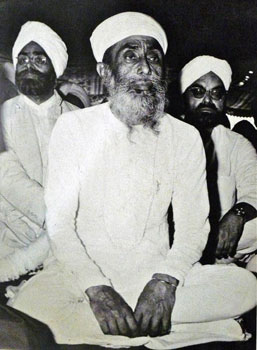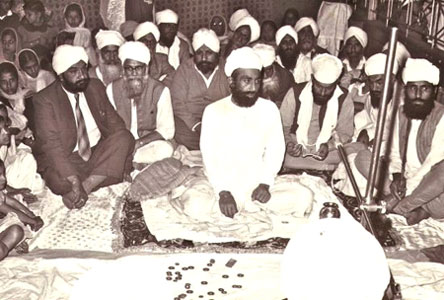|

Satguru
Jagjit Singh in Preet Nagar in 1977 at the bhog ceremony of
the memorial of Gurbakhsh Singh, the master of modern
Punjabi prose. Sitting at the back on the floor (left) Giani
Zail Singh then Punjab chief minister and on the right is
Gurdial Singh Dhillon, Speaker of Lok Sabha the lower house
of Indian parliament
Satguru Jagjit Singh was the spiritual head of the Namdhari
or Kuka sect of Sikhs founded in 1842 by Balak Singh
(1799–1862) in northwest Punjab. Ram Singh a carpenter of
Bhaini Arăean, a village in eastern Punjab, had served in
the Sikh army of Maharaja Ranjit Singh who was succeeded him
by Balak Singh. After the annexation of the Punjab by the
British, Satguru Ram Singh grudgingly led the mass unrest by
adopting socio-religious reformist posture against casteism
and idolatry, which had crept into the Sikh faith. He
claimed to be a reincarnation of Gobind Singh (1666-1708),
the 10 th Guru of the Sikhs and the future ruler of
Hindustan. His political message was anti-British. He openly
called for total non-cooperation with the British and the
promotion of indigenous industries and ran a parallel state
structure which had its own law courts, schools, postal and
taxation system. The British government saw him as a threat
and arrested him. He was banished to Burma where he died in
1885 in custody. Forty years later, Gandhi was to pursue the
same path of non-violent struggle.
Satguru Ram Singh was succeeded by his younger brother Hari
Singh and Jagjit Singh was the fourth in the line. Jagjit
Singh’s father Partap Singh was a staunch supporter of the
Indian National Congress in the freedom struggle and this
relationship still continues and Namdharis are guaranteed
vote bank of the ruling Congress Party. A Namdhari
industrialist headed the Punjab State Congress committee
early this decade. Satguru Partap Singh was one of the
leaders of the World Peace movement in the early 1950s
sponsored by the Soviet Union. Namdharis’ soft-spot towards
the atheist Indian communist party is well known. They
harboured Punjabi communist leaders while the party was
banned just after 1947.
During the last 50 years apart from him preaching his faith,
Satguru Jagjit Singh’s most remarkable role was his
dedicated efforts of keeping alive the tradition of Indian
classical music. He himself was an accomplished player of
Dil Ruba and had encyclopaedic knowledge of ancient
classical compositions. His father and four Muslim music
teachers - Ustad Udho Khan, Ustad Rahim Bakhash, Bhai Naseer
and Bhai Taba trained him
What distinguished the Namdharis from the orthodox Sikhs was
their belief in a personal line of Gurus after the 10 th
Guru. They do not worship the Adi Granth the Sikh Holy Book.
In the absence of the living Guru, in the Gurdwara –temple–
his photographic image adorns the wall and in the forefront
the raised seat is left empty. When he is present in the
congregation, devotees touch his feet bowing their heads.
The Namdharis strictly adhere to non-violence,
vegetarianism, temperance, dress code of wearing white hand
spun cotton and men wearing turbans horizontally across the
forehead and drinking groundwater from the well. They have
kept some typical orthodox Hindu rituals like havana (holy
fire) for worship and mass wedding ceremonies. Austerely
dressed in white with their heads covered women have equal
rights and wear no goldornaments and make up. The Namdharis
claim that Satguru Ram Singh was the first to allow women to
perform Amrit Sanskar – the Khalsa initiation; and to
abolish dowry, child marriage and trade in girls.

Satguru Jagjit Singh in Nairobi. 1959. Photo by PS Matharu
In the first half of last century, the Sikhs were a
well-established community in Kenya as compared to Sikh
settlements in the Far East. As the Sikh community in East
Africa comprised mainly of artisans, they after having newly
acquired affluence asserted their identity by establishing
East African Ramgarhia Board, Namdhari Sangat and caste and
sect-based gurdwaras and even sought separate electorates
and reserved seats for themselves in the Legislative Council
of Kenya. (Kenyan Sikh communists Makhan Singh, Gopal Singh
Chandan and his associates denounced such demand as
‘reactionary, disruptive and divisive’. In this cause, they
found support from the Congress, the Agha Khan and his
followers - East African Ismailis. As a matter of record,
Makhan Singh went on a seven-day fast in June 1948 as ‘a
supreme effort to rouse the honest consciousness of the
Indian people, and that of the leaders of the East African
Indian National Congress and other organisations’.
Eventually the issue of separate electorates was shelved.)
This was the phenomenon that could have happened abroad
only, though it was to take place in the Punjab half a
century later. Satguru Partap Singh was the first ever
Namdhari head who visited Kenya followed by his successor
son during the late 1950s. After that Satguru Jagjit Singh
travelled regularly worldwide to his followers, which
numbered about a million, mostly skilled workers and
professionals settled in various countries like Thailand,
Australia and the Americas including the United Kingdom.

Satguru Jagjit Singh playing dilruba. c1960.
Photo by Niranjan Singh Nakodari
In 1959, Jagjit Singh at the age of 39 assumed the spiritual
throne after the death of his father Satguru Partap Singh.
He was unassuming and soft spoken. Behind his pock marked
face lay a humble soul. He had no formal education in the
British colonial education system though his father had him
privately tutored in Punjabi to read Sikh scriptures and
theology. He religiously followed the routine of getting up
early at two o’clock and washing with spring water. On his
visits to England his followers collected water for him from
the river Iver.
Though he made no claims of being a messiah he had one
noteworthy miracle to his credit: In August 1976 while he
was visiting London he made rain fall after a long spell of
draught by performing havanayajna prayers. It poured down
for twenty days. The British TV channels and tabloids hailed
him as the Rain God and Rain Maker.
During the last 50 years apart from him preaching his faith,
his most remarkable role was his dedicated efforts of
keeping alive the tradition of Indian classical music. He
himself was an accomplished player of Dil Ruba a traditional
string and bow instrument and had encyclopaedic knowledge of
ancient classical compositions. His father and four Muslim
music teachers - Ustad Udho Khan, Ustad Rahim Bakhash, Bhai
Naseer and Bhai Taba trained him.
Many non-Sikh maestros like Alla Rakha Khan, Vilayat Khan,
Ali Akbar Khan, Pandit Ravi Shankar, Amjad Ali Khan, Pandit
Krishan Maharaj, Hari Prasad Chaurasia and Rajan and Sajan
Mishra held him in great esteem and gained from his vast
knowledge of music sitting literally at his feet. Under his
patronage all these masters trained many Namdhari vocalists
and instrumentalists notable among them Gurdev Singh (Sarod)
and Sukhwinder Singh (Tabla).
The Satguru patronised leading Punjabi authors like Sant
Singh Sekhon and helped them in their hour of need. Apart
from the cash they received a tin canister each full of ghee
refined cow butter.
As a nature lover the Satguru cared for environmental
issues. He oversaw several projects of growing gardens in
desert areas, horticulture in sand dunes, seed farming
through a multi-national company with multi-million dollar
turnover, horse stud farms and cattle breeding centres.
His wife and daughter survive him. As he had no male heir,
it was thought that most probably his son in law would
succeed him as the head of the Namdharis. The power tussle
had started well before his end. On the day of his cremation
his nephew Thakur Uday Singh (54) was however named the next
Satguru, who is seen by his opponents as a tycoon and not a
spiritual being.
Satguru Jagjit Singh, Spiritual leader of Namdhari Sikhs,
born Bhaini Arăean 22 November1920; died Ludhiana 13
December 2012
-0-
|

